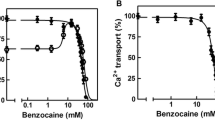Summary
In order to characterize the interaction of reserpine, chlorpromazine, tetracaine, and quinidine with membrane phenomena, electrophysiological studies were performed on frog skeletal muscle fibers under various ionic environments. In addition the influence of these drugs on the contractility of the frog skeletal muscle was investigated.
-
1.
Measurements of intracellular membrane potentials of the sartorius muscle fibers revealed that tetracaine, quinidine, chlorpromazine, and reserpine diminished the depolarizing action of high [K+]0: while the resting potential in normal Ringer's solution fell from −90 mV to −9.3 mV when 100 mM NaCl was replaced by the same amount of KCl, a time and dose-dependent increase of the membrane potential depolarized by potassium was observed after addition of these drugs. The order of the polarizing potency was reserpine > chlorpromazine > tetracaine > quinidine.
-
2.
Maximal stabilizing effects (i. e. increase of the membrane potential in 100 mM KCl Ringer's solution to more negative values) were observed with the following drug concentrations (20 min incubation time): reserpine 10−4 M (13 mV increase); chlorpromazine 3 X104 M (21 mV increase); quinidine 3 × 10−3 M (15 mV increase); tetracaine 10−2M (28 mV increase). At higher concentrations, reversion of the polarizing effects occurred as a consequence of labilization of the muscle membrane.
-
3.
Evidence for such a biphasic effect, i.e. stabilizing-labilizing effect of the drugs came also from measurements of the relative membrane resistanceR r. In 100 mM KCl Ringer's solution tetracaine in concentrations up to 10−3 M caused an absolute increase. Higher concentrations produced again a subsequent fall ofR r. Quinidine, chlorpromazine and reserpine inhibited only the time-dependent decrease ofR r normally found in control preparations.
-
4.
In chloride-deficient 112 mM KCH3S04 Ringer's solution, tetracaine produced a several fold higher increase ofR r. Under these experimental conditions also quinidine and chlorpromazine caused an absolute enhancement ofR r, but not reserpine. These findings indicate that chiefly the potassium conductanceg K of the muscle fiber membrane was affected by tetracaine, chlorpromazine, and quinidine.
-
5.
Tetracaine, quinidine, chlorpromazine, and reserpine inhibited the KCl-induced contractions of the sartorius muscle as well as the acetylcholine-induced mechanical activity of the frog rectus abdominis muscle.
-
6.
From the results it is concluded that the different drugs used in this investigation may exert their effects by a rather common mechanism, i.e. via membrane stabilization; this is indicated by the observed impairment of the membrane permeability for cations.
Similar content being viewed by others
References
Adrian, R. H.: The effect of internal and external potassium concentration on the membrane potential of frog muscle. J. Physiol. (Lond.)133, 631–658 (1956).
—, Freygang, W. H.: The potassium and chloride conductance of frog muscle membrane. J. Physiol. (Lond.)163, 61–103 (1962).
Balzer, H., Hellenbrecht, D.: Beeinflussung des Calcium-Austausches und der Muskelfunktion des M. rectus und sartorius des Frosches durch Chlorpromazin, Prenylamin, Imipramin und Reserpin. Naunyn-Schmiedebergs Arch. Pharmak.264, 129–146 (1969).
Bianchi, C. P., Lakshminarayanaiah, N.: Pharmacology of excitation-contraction coupling in muscle. Introduction: statement of the problem. Fed. Proc.28, 1624–1628 (1969).
Boyle, P. J., Conway, E. J.: Potassium accumulation in muscle and associated changes. J. Physiol. (Lond.)100, 1–63 (1941).
Bozler, E., Cole, K. S.: Electric impedance and phase angle of muscle in rigor. J. cell. comp. Physiol.6, 229–241 (1935).
Fatt, P., Katz, B.: An analysis of the plate potential recorded with an intracellular electrode. J. Physiol. (Lond.)115, 320–370 (1951).
Fleckenstein, A.: Der Kalium-Natrium-Austausch als Energieprinzip in Muskel und Nerv. Berlin-Göttingen-Heidelberg: Springer 1955.
Hajdu, S.: Effect of drugs, temperature, and ions on Ca++ of coupling system of skeletal muscle. Amer. J. Physiol.218, 966–972 (1970).
Harris, E. J., Ochs, S.: Effects of sodium extrusion and local anesthetics on muscle membrane resistance and potential. J. Physiol. (Lond.)187, 5–21 (1966).
Hodgkin, A. L., Horowioz, P.: The influence of potassium and chloride ions on the membrane potential of single muscle fibres. J. Physiol. (Lond.)148, 127–160 (1960).
Hellenbrecht, D., Balzer, H.: The effect of reserpine and chlorpromazine on the resting potential and the membrane resistance of the frog sartorius muscle after potassium depolarization. Naunyn-Schmiedebergs Arch. Pharmak.266, 352 (1970).
Iravani, J.: Wechselbeziehung von Barbituraten und Piperazin mit GABA an der Membran des Krebsmuskels. Naunyn-Schmiedebergs Arch. exp. Path. Pharmak.251, 265–274 (1965).
Jenerick, H. P.: Muscle membrane potential, resistance and external potassium. J. cell. comp. Physiol.42, 427–448 (1953).
Katz, B.: The electrical properties of the muscle fibre membrane. Proc. roy. Soc. B135, 506–534 (1948).
—: Nerve, muscle, and synapse, pp. 1–193. New York: McGraw-Hill Book Comp. 1966.
Kraatz, C. P.: Contractions of the frog rectus abdominis muscle induced by phenothiazines. Pharmacologist2, 69 (1960).
Lüttgau, H. C., Oetliker, H.: The action of caffeine on the activation of the contractile mechanism in striated muscle fibres. J. Physiol. (Lond.)194, 51–74 (1968).
Schanne, O., Kawata, H., Schäfer, B., Lavallee, M.: A study on the electrical resistance of the frog sartorius muscle. J. gen. Physiol.49, 897–912 (1966).
Seeman, P. M.: Membrane stabilization by drugs: Tranquilizers, steroids, and anesthetics. Int. Rev. Neurobiol.9, 145–221 (1966).
Shanes, A. M.: Drug and ion effects in frog muscle. J. gen. Physiol.33, 729–744 (1950).
—: Electrochemical aspects of physiological and pharmacological action in excitable cells. Part I: The resting cell and its alteration by extrinsic factors. Pharmacol. Rev.10, 59–164 (1958).
Sperelakis, N., Schneider, M. F., Harris, E. J.: Decreased K+ conductance produced by Ba++ in frog sartorius fibers. J. gen. Physiol.50, 1565–1583 (1967).
Author information
Authors and Affiliations
Additional information
Part of this work has been presented on the 11. Frühjahrstagung der Deutschen Pharmakologischen Gesellschaft, Mainz 1970 (Hellenbrecht and Balzer, 1970).
Supported by a grant from the Deutsche Forschungsgemeinschaft.
Rights and permissions
About this article
Cite this article
Hellenbrecht, D. Stabilizing-labilizing effects of reserpine, chlorpromazine, tetracaine, and quinidine on frog skeletal muscle fibers. Naunyn-Schmiedebergs Arch. Pharmak. 271, 125–141 (1971). https://doi.org/10.1007/BF00998574
Received:
Issue Date:
DOI: https://doi.org/10.1007/BF00998574




